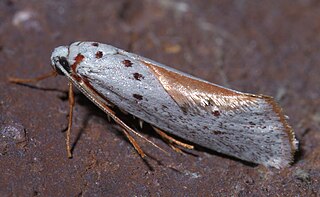Related Research Articles

Atteva is a genus of moths in the monotypic family Attevidae. The group has a pantropical distribution; however, the range of at least one species, Atteva aurea, extends into the temperate zone. No consistent hypotheses regarding the relationships, placement, and ranking of Attevidae have been published, but the prevalent view is that they likely form a monophyletic group within the Yponomeutoidea.

Epermeniidae or the fringe-tufted moths is a family of insects in the lepidopteran order with about 14 genera. Previously they have been divided in two subfamilies Epermeniinae and Ochromolopinae but this is no longer maintained since the last group is probably hierarchically nested within the first. They are presently placed in their own superfamily but have previously been placed among the Yponomeutoidea or Copromorphoidea with which they share some features. Their systematic placement among the apoditrysian group "Obtectomera" is however uncertain. They show some morphological similarities to the "plume moths", for example the wing fringe has similar groups of scales. There are also some similarities to Schreckensteinioidea, for example spiny legs and at least in some species an open-network cocoon. The genus Thambotricha from New Zealand may be the sister group of all other extant members. The most important genera are Epermenia, Ochromolopis and Gnathifera. The group has been extensively revised and catalogued by Dr Reinhard Gaedike.

The Lacturidae comprise a family of moths in the superfamily Zygaenoidea. Brightly coloured tropical moths, the Lacturidae have been previously placed in the Plutellidae, Yponomeutidae, and Hyponomeutidae.

Urodidae, whose species are commonly known as false burnet moths, is a family of moths in the lepidopteran order. It is the type genus in the superfamily, Urodoidea, with three genera, one of which, Wockia, occurs in Europe.
Tylanthes is a monotypic moth genus in the subfamily Arctiinae. Its only species, Tylanthes ptochias, is found in Australia and New Guinea. It is found in both lowland and highland habitats. Both the genus and species were first described by Edward Meyrick in 1889.

Adoxophyes is a genus of moths of the tribe Archipini.

Archips is a genus of tortrix moths the tribe Archipini. Species include the oak leaf roller, which eats the leaves of oak trees.

Xyloryctidae is a family of moths contained within the superfamily Gelechioidea described by Edward Meyrick in 1890. Most genera are found in the Indo-Australian region. While many of these moths are tiny, some members of the family grow to a wingspan of up to 66 mm, making them giants among the micromoths.

Gymnogramma is a genus of moths in the family Lacturidae.

Cyme pyraula is a moth of the family Erebidae first described by Edward Meyrick in 1886. It is found in the Australian state of Queensland and on New Guinea.
Lactura pyrilampis is a moth of the family Lacturidae. It was described by Edward Meyrick in 1886. It is found on New Guinea and Papua New Guinea.
Eugoa dissozona is a moth of the family Erebidae first described by Edward Meyrick in 1889. It is found on New Guinea, where it is a common and widely distributed species. Specimens resemble those of Eugoa regalis. In his original description of the species, Meyrick gave a wingspan of 24 mm.
Teratopora haplodes is a moth in the family Erebidae. It was described by Edward Meyrick in 1889. It is found in New Guinea, where it has been recorded from Papua New Guinea and Papua. The habitat consists of lowland areas.

Lactura is a genus of moths in the family Lacturidae.

Lactura erythractis is a moth of the Lacturidae family. It is known from Australia, where it has been recorded from Queensland and the Northern Territory.
Imma spanista is a moth of the family Immidae. It was described by Edward Meyrick in 1930. It is found on New Guinea and Papua New Guinea.
Eugene Gordon Munroe was a Canadian entomologist who discovered numerous species of insects. He worked for the Insect Systematics and Biological Control Unit, Entomology Division in Ottawa, Ontario, Canada.
Anticrates chrysantha is a moth of the family Lacturidae first described by Edward Meyrick in 1905. It is found in Sri Lanka.
References
- ↑ Savela, Markku (ed.). "Darantoides lineolata Hulstaert, 1924". Lepidoptera and Some Other Life Forms. Retrieved October 13, 2019.
- ↑ De Vos, Rob. "Lactura pyronympha Meyrick, 1923 | The Tropical Burnet Moths (Lepidoptera: Lacturidae) of Papua Indonesia". Papua-Insects.nl. The Papua Insects Foundation.